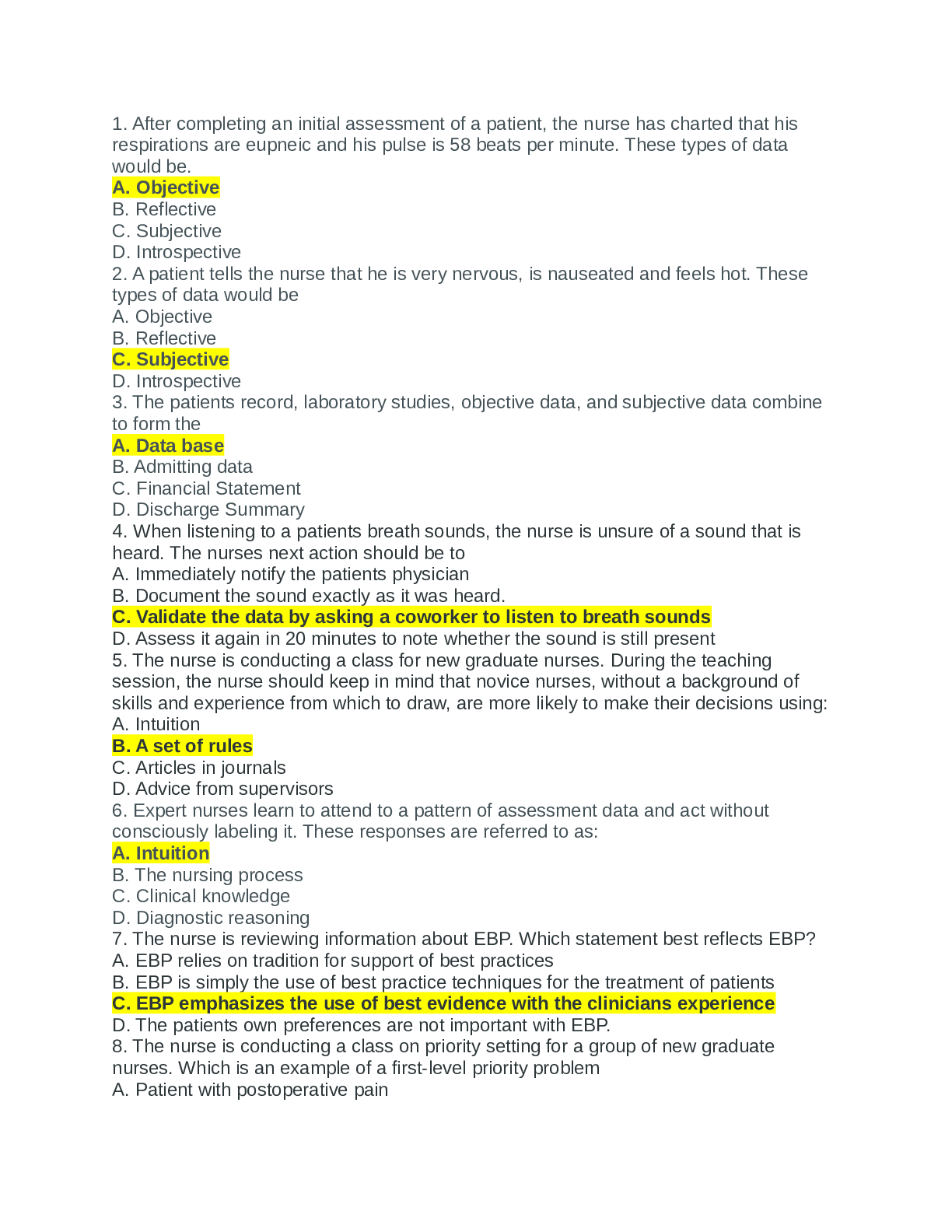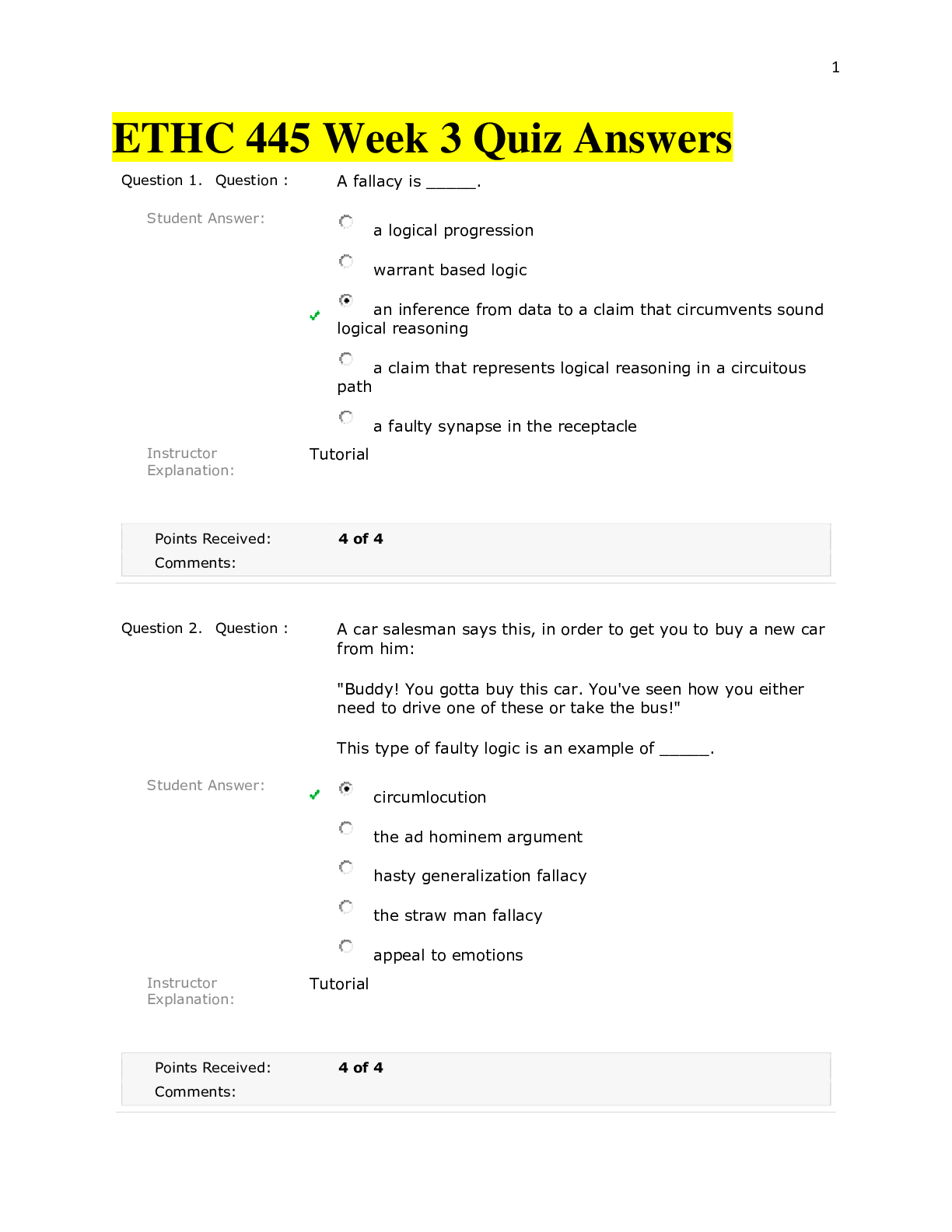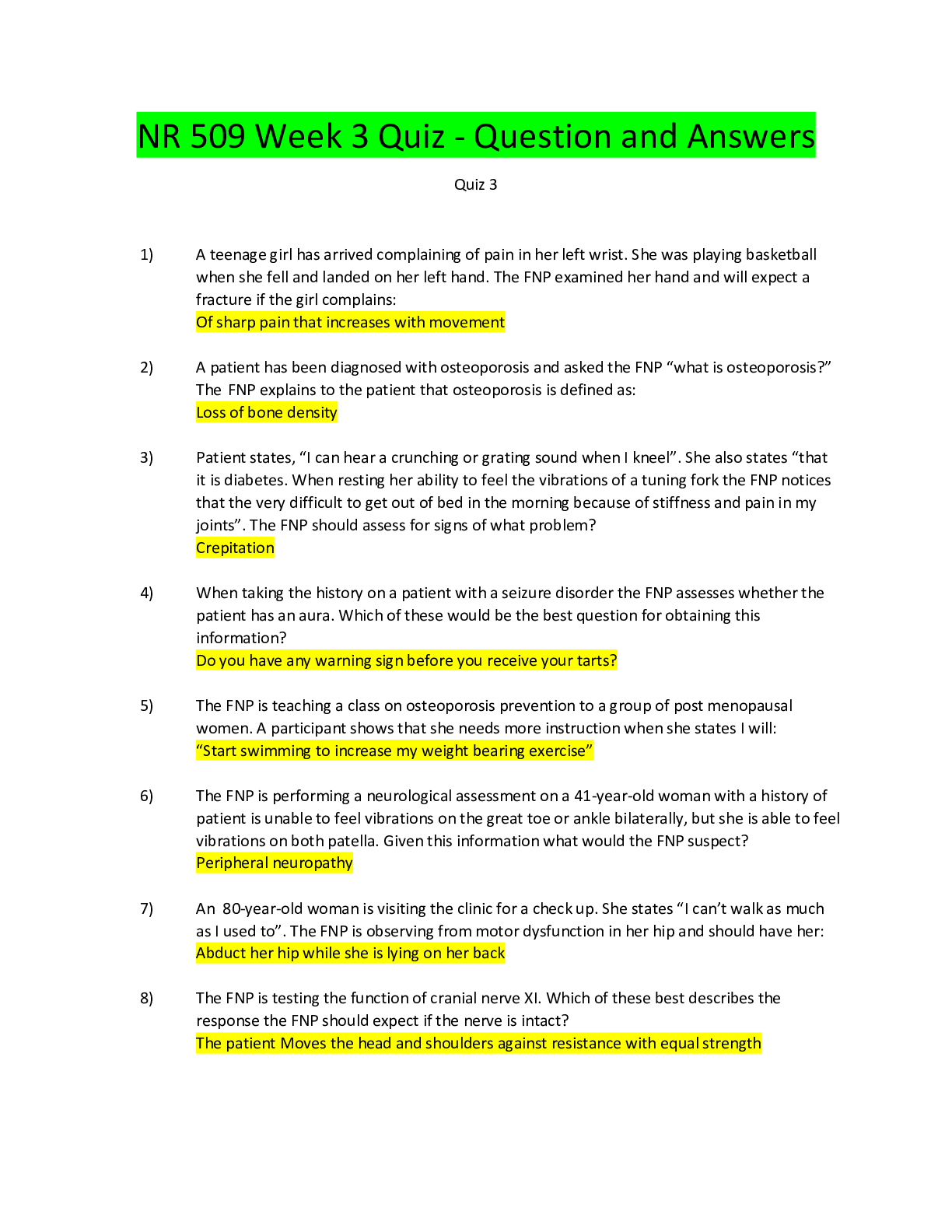*NURSING > QUESTIONS & ANSWERS > NR 509 Week 3 Quiz and Answers (All)
NR 509 Week 3 Quiz and Answers
Document Content and Description Below
The FNP is doing an assessment on a 29-year-old woman who visits the clinic c/o always dropping things and falling down. While testing rapid alternating movements, the FNP notices that the woman is u... nable to pat both her knees. Her response is very slow, and she misses frequently. What should the FNP suspect? *Vestibula disease *Dysfunction of the cerebellum *Lesion of cranial nerve XI *Inability to understand directions Rational: The cerebellum receives information about the position of muscles and joints, the equilibrium of the body, and what kind of motor messages are being sent from the cortex to the muscles. The information is integrated, and the cerebellum uses feedback pathways to exert its control back on the cortex or down to lower motor neurons in the spinal cord. The cerebellum does not initiate movement but coordinates and smooths it. It is like the “autopilot” on an airplane in that it adjusts and corrects the voluntary movements but operates entirely below the conscious level. ------------------------------------------------------------------------------------------------------------------------------- A women who is 8 months pregnant comments that she has noticed a change in posture and is having lower back pain. The FNP tells her that during pregnancy women have a posture shift to compensate for the enlarging fetus. This shift in posture is known as: *lordosis *ankylosis *scoliosis *compression Rational: increased levels of circulating hormones cause increased mobility in the joints. Increased mobility in the sacroiliac, sacrococcygeal, and symphysis pubis joints in the pelvis contributes to the noticeable changes in maternal posture. The most characteristic change is progressive lordosis, which compensates for the enlarging fetus; otherwise the center of balance would shift forward. Lordosis compensates by shifting the weight farther back on the lower extremities. This shift in balance in turn creates strain on the back on the low back muscles, which in some women is felt as low back pain during late pregnancy. ------------------------------------------------------------------------------------------------------------------------------- When taking the history on a patient with a seizure disorder, the FNP assesses whether the patient has an aura. Which of these would be the best question for obtaining this information? *does your muscle tone seem tense or limp? *after the seizure, do you spend a lot of time sleeping? *do you have any warning sign before your seizure starts? *do you experience any color change or incontinence during the seizure? Rational: Aura is a subjective sensation that precedes a seizure; it could be auditory, visual, or motor. This study source was downloaded by 100000796615030 from CourseHero.com on 08-28-2021 05:30:03 GMT -05:00 https://www.coursehero.com/file/35255671/Week-3-Quiz-Neurodocx/ This study resource was shared via CourseHero.com 2 During the history, a patient tells the FNP that “it feels like the room is spinning around me”. The FNP would document this as: *vertigo *syncope *dizziness *seizure activity Rational: Vertigo is true rotational spinning often from labyrinthine-vestibular disorder in inner ear. With objective vertigo the person feels like the room is spinning; with subjective vertigo the person feels like he or she is spinning. ------------------------------------------------------------------------------------------------------------------------------- A patient is complaining of pain in his joints that is worse in the morning, is better after he has moved around for a while, and then gets worse again if he sits for long periods of time. The FNP should assess for other signs of what problem? *Tendinitis *OA *RA *Intermittent claudication Rational: RA pain is worse in the morning when arising; OA is worse later in the day; tendinitis is worse in the morning, improves during the day. ------------------------------------------------------------------------------------------------------------------------------- A patient is able to flex his right arm forward without difficulty or pain but is unable to abduct his arm because of pain and muscle spasms; the FNP should suspect: *crepitation *rotator cuff lesions *dislocated shoulder *rheumatoid arthritis Rational: Rotator cuff lesions may cause limited ROM, crepitus with motion, pain, and muscle spasm during abduction. ------------------------------------------------------------------------------------------------------------------------------- In obtaining a history on a 74 year old patient the FNP notes that he is drinking alcohol daily and that he has noticed a tremor in his hands that affect his ability to hold things. With this information, what should the FNP response be? *Does your family know you are drinking every day? *Do the tremors change when you drink the alcohol? *We’ll do some tests to see what is causing the tremors? *You really shouldn’t drink so much alcohol, it may be causing your tremors. Rational: Senile tremor is relieved by alcohol but his is not a recommended treatment. Assess if the person is abusing alcohol in effort to relieve tremor. This study source was downloaded by 100000796615030 from CourseHero.com on 08-28-2021 05:30:03 GMT -05:00 https://www.coursehero.com/file/35255671/Week-3-Quiz-Neurodocx/ This study resource was shared via CourseHero.com 3 The FNP suspects that a patient has carpal tunnel syndrome and wants to perform the Phalen’s test. To perform this test, the FNP should instruct the patient to: *dorsiflex the foot *plantarflex the foot *hold both hands back to back while flexing the wrist 90degrees for 60 seconds. *hyperextend the wrist with the palmer surface of both hands touching and wait for 60 seconds. Rational: to perform the Phalen test, ask the person to hold both hands back to back while flexing the wrist 90 degrees. Acute flexion of the wrist for 60 seconds produces no symptoms in the normal hand. ------------------------------------------------------------------------------------------------------------------------------- The FNP is teaching a class on osteoporosis prevention to a group of postmenopausal women. A participant shows hat she needs more instructions when she states, “I will: *start swimming to increase my weight-bearing exercise *try to stop smoking as soon as possible * get a bone-density test soon Rational: Lifestyle affects musculoskeletal changes; a sedentary lifestyle hastens musculoskeletal changes of aging. Although beneficial for cardiovascular health, swimming is not an example of weight-bearing activity. ------------------------------------------------------------------------------------------------------------------------------- When the FNP asks a 68 year old patient to stand with his feet together and arms at this side with his eyes closed, he starts to sway and moves his feet farther apart. The FNP would document this finding as: *ataxia *lack of coordination *negative Homan’s sign *positive Romberg sign Rational: Romberg sign is loss of balance that occurs when closing the eyes. You eliminate the advantage of orientation with the eyes, which had compensated for sensory loss. A positive Romberg sign occurs with cerebellar ataxia (MS, alcohol intoxication), loss of proprioception, and loss of vestibular function. ------------------------------------------------------------------------------------------------------------------------------- The assessment of a 60-year old patient has taken longer than anticipated. In testing his pain perception, the FNP decides to complete the test as quickly as possible. When the FNP applies the sharp point of the pin on his arm several times, he is only able to identify these as one “very sharp prick”. What would be the most accurate explanation for this? *Patient has hyperesthesia as a result of the aging process *This is most likely the result of the summation effect *The FNP was probably not poking hard enough with the pin in the other areas *The patient most likely has analgesia in some areas of arm and hyperalgesia in others This study source was downloaded by 100000796615030 from CourseHero.com on 08-28-2021 05:30:03 GMT -05:00 https://www.coursehero.com/file/35255671/Week-3-Quiz-Neurodocx/ This study resource was shared via CourseHero.com 4 Rational: Pain is tested by the person’s ability to perceive a pinprick. With summation, frequent consecutive stimuli are perceived as one strong stimulus. To avoid summation, let at least 2 seconds elapse between each stimulus. No evidence exists to suggest that older individuals perceive pain to a lesser degree or that sensitivity is diminished. ------------------------------------------------------------------------------------------------------------------------------- A professional tennis player comes into the clinic complaining of a sore elbow. The FNP will assess for tenderness at the: *olecranon bursa *annular ligament *base of the radius *medial and lateral epicondyle Rational: Epicondyles, head of radius, and tendons are common sites of inflammation and local tenderness, or “tennis elbow”. Palpate with the elbow flexed about 70 degrees and as relaxed as possible. Use your left hand to support the person’s left forearm and palpate the extensor surface of the elbow-the olecranon process and the medial and lateral epicondyles of the humerus-with your right thumb and fingers. ------------------------------------------------------------------------------------------------------------------------------- This study source was downloaded by 100000796615030 from CourseHero.com on 08-28-2021 05:30:03 GMT -05:00 https://www.coursehero.com/file/35255671/Week-3-Quiz-Neurodocx/ This study resource was shared via CourseHero.com [Show More]
Last updated: 1 year ago
Preview 1 out of 4 pages

Buy this document to get the full access instantly
Instant Download Access after purchase
Add to cartInstant download
We Accept:

Reviews( 0 )
$8.00
Document information
Connected school, study & course
About the document
Uploaded On
Aug 28, 2021
Number of pages
4
Written in
Additional information
This document has been written for:
Uploaded
Aug 28, 2021
Downloads
0
Views
78


.png)
.png)
.png)
.png)
.png)
.png)
.png)
.png)
.png)
.png)
.png)














